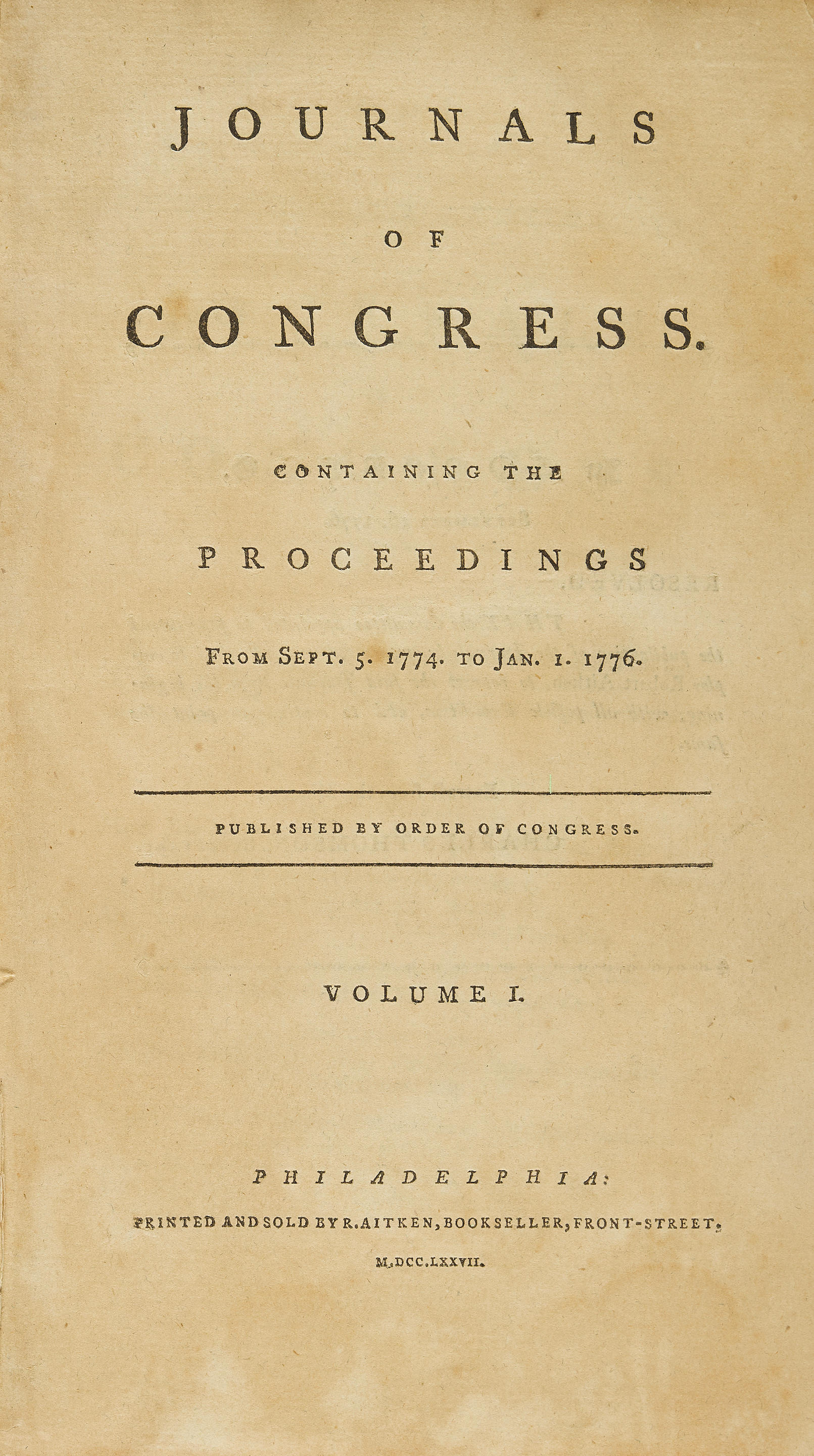Continental CongressThe Journals of the Proceedings of Congress. Held at Philadelphia, from January to May, 1776. Philadelphia: Printed R. Aitken, 1776
4 parts bound in one volume (215 x 129 mm). Lacking title pages to February and March, as normal, library stamp to verso of title page, scattered spotting, toning and occasional damp staining to leaves, a few short closed marginal tears. Original paper boards, untrimmed. Clamshell box.
The rare original printing of the Congressional Journals for early 1776 — the "Cartridge Paper" edition.
Through 1775, the Bradford family had the contract to print the Journals of Congress, but beginning with these Journals, the contract was moved to Robert Aitken. These journals were issued in monthly parts, although whole runs generally disposed with the monthly titles issued in February and March. After April, Aitken was told to cease publication. It is noted in Aitken's "Waste Book" at the Library Company of Philadelphia, that he sold a mere 80 copies of this edition. In the fall of 1776, Congress charged Aiken to reprint all of its earlier Journals from 1774 through April 1776 as the first volume of the collected Journals of Congress. With this work in progress, Aitken disposed of the remaining January to April edition, giving them to the Army to be used for cartridges (hence the "Cartridge Paper" edition).
As only 80 copies survived, the present edition is perhaps the rarest of all early Journals of Congress. These Journals of early 1776 cover some of the most critical moments of the Revolution, forming "the only central record of the colonies and the subsequent states" (Tanenbaum, 12). They covered four months of one of the most critical periods in American Revolutionary history. In January 1776, following the publication of Thomas Paine's Common Sense (lot CZPJ2), public opinion moved the Second Continental Congress toward open rebellion.
"On New Year's Day, Monday , January 1 1776, the first copies of the speech delivered by King George III at the opening of Parliament back in October were sent across the lines to Boston... Word of its contents rapidly spread. Its charges of traitorous rebellion, its ominous reference to "foreign assistance," assuredly ended any hope of reconciliation or a short war. It marked a turning point as clear as the advent of the new year (McCullough, 67-8). Soon after this "Congress definitely advanced from being a mere clearinghouse for colonial opinion toward becoming the superintening power over the the unified colonial cause... as the conviction gathered strength that only by the arbitrament of arms could the prized liberties be preserved, the idea of independence had laid its grip upon the public mind" (Andrews, 248).
REFERENCE:Celebration of My Country 65; Evans 15145
Continental CongressThe Journals of the Proceedings of Congress. Held at Philadelphia, from January to May, 1776. Philadelphia: Printed R. Aitken, 1776
4 parts bound in one volume (215 x 129 mm). Lacking title pages to February and March, as normal, library stamp to verso of title page, scattered spotting, toning and occasional damp staining to leaves, a few short closed marginal tears. Original paper boards, untrimmed. Clamshell box.
The rare original printing of the Congressional Journals for early 1776 — the "Cartridge Paper" edition.
Through 1775, the Bradford family had the contract to print the Journals of Congress, but beginning with these Journals, the contract was moved to Robert Aitken. These journals were issued in monthly parts, although whole runs generally disposed with the monthly titles issued in February and March. After April, Aitken was told to cease publication. It is noted in Aitken's "Waste Book" at the Library Company of Philadelphia, that he sold a mere 80 copies of this edition. In the fall of 1776, Congress charged Aiken to reprint all of its earlier Journals from 1774 through April 1776 as the first volume of the collected Journals of Congress. With this work in progress, Aitken disposed of the remaining January to April edition, giving them to the Army to be used for cartridges (hence the "Cartridge Paper" edition).
As only 80 copies survived, the present edition is perhaps the rarest of all early Journals of Congress. These Journals of early 1776 cover some of the most critical moments of the Revolution, forming "the only central record of the colonies and the subsequent states" (Tanenbaum, 12). They covered four months of one of the most critical periods in American Revolutionary history. In January 1776, following the publication of Thomas Paine's Common Sense (lot CZPJ2), public opinion moved the Second Continental Congress toward open rebellion.
"On New Year's Day, Monday , January 1 1776, the first copies of the speech delivered by King George III at the opening of Parliament back in October were sent across the lines to Boston... Word of its contents rapidly spread. Its charges of traitorous rebellion, its ominous reference to "foreign assistance," assuredly ended any hope of reconciliation or a short war. It marked a turning point as clear as the advent of the new year (McCullough, 67-8). Soon after this "Congress definitely advanced from being a mere clearinghouse for colonial opinion toward becoming the superintening power over the the unified colonial cause... as the conviction gathered strength that only by the arbitrament of arms could the prized liberties be preserved, the idea of independence had laid its grip upon the public mind" (Andrews, 248).
REFERENCE:Celebration of My Country 65; Evans 15145















Try LotSearch and its premium features for 7 days - without any costs!
Be notified automatically about new items in upcoming auctions.
Create an alert